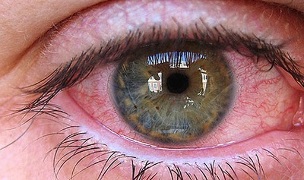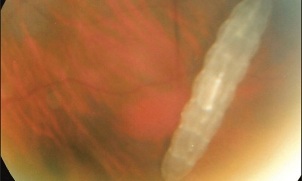
Eye parasites are round and flat worms, less often annelides and worms of prickly heads, larvae of flies and mosquitoes. Penetrating into the human body, they gradually spread through it, damaging tissues and organs. Most of them are capable of parasitizing in the human eye, causing the development of ophthalmic helminthiasis.
Clinically, these severe pathologies are manifested by pain, burning, itching, visual disturbances, lacrimation. Immediately after the diagnosis, surgical and (or) conservative treatment is performed.
Diseases caused by parasites in the eyes
More than 50 causes of ophthalmic helminthiasis in humans are known. Some penetrate directly through the mucosa, damaging the conjunctiva or tear ducts. Others infect the eyeball from the inside, moving into it with a stream of blood from the intestines or liver. Parasites begin to actively grow and multiply, laying eggs, leading to partial or complete loss of vision.
Most commonly diagnosed ophthalmic helminthiasis:
- onchocerciasis- helminthiasis caused by parasitism in the human body onchocerca nematode (onchocercias). Its specific symptom is “blurring” of the cornea of the eye;
- ophthalmomiasisis a parasitic disease of the eye and its appendages that occurs when the larvae of flies or gadflies enter. In severe cases of myiasis, retinal detachment or optic nerve atrophy is possible;
- heartworm disease- helminthiasis that develops when the larva of a filamentous nematode attacks the eyeball. Worm movements cause tingling, severe pain, and itching;
- sparganosisis a human disease from the cestode group caused by tapeworm larvae of the genus Spirometer. Infection mainly occurs when eating the meat of wild animals;
- toxocariasisis a chronic infectious disease caused by the larvae of the toxocara roundworm. The source of infection is a sick animal (usually a dog);
- toxoplasmosisis a chronic parasitic invasion caused by intracellular protozoa (toxoplasma). Their vital activity is accompanied by the constant release of allergens and toxins;
- coenurosisis a predominantly chronic disease that occurs after helminth infection from the cestode group of Taenia multiceps. A person becomes infected by contact with dogs;
- cysticercosis- a disease caused by the larva of porcine tapeworm that can lead to reduced vision and blindness;
- gnathostomosis- the disease causes severe pain and often leads to death. Worms that cause this disease more often affect the skin, less often the central nervous system and eyes;
- Echinococcosis of the eyesis a fairly common disease. It is characterized by the formation of parasitic cysts in the orbital zone. Echinococcosis develops due to the ingestion of parasite eggs by food or water.
- eye demodicosis, caused by the activation of mites that live in the sebaceous glands of the eyelashes.
- Trichinosisis a parasitic pathology that develops after the introduction of the Trichinella spiral nematode into the human body.

They are not sexually mature individuals and larvae dangerous to the eyes, but toxins that they release. They cause swelling of the eyelids and redness of the mucous membranes.
Symptoms of eye parasites
Each helminthic invasion has its own specific symptoms. But they also have many common signs of damage to the mucous membranes and deeper eye structures.
In the initial stages of pathology development, typical manifestations of conjunctivitis appear:
- redness of the outer shell of the eyeball;
- increased lacrimation;
- photophobia;
- swelling of the upper and lower eyelids;
- pain, itching, burning;
- headaches localized in the temples and nape of the neck;
- slight increase in local temperature.
Young children and weak people develop symptoms of general intoxication of the body. The temperature rises above subfebrile values (37, 1-38, 0 ° C), appetite decreases due to attacks of nausea and vomiting.
Unlike many infections caused by viruses, bacteria and fungi, the course of helminthic invasions is accompanied by signs of damage to other organs. These are pain in the migratory muscles, dry skin, slowed hair growth and indigestion.
How to get rid of parasites from the eyes
Biplane larvae, protozoa, ticks and other pathogens of parasitic diseases can quickly destroy eye structures. Therefore, treatment is carried out immediately after diagnosis. When choosing therapeutic tactics, doctors take into account the type of infectious agents, the severity of the course of the disease and the severity of symptoms.
If an infected person goes to doctors with advanced helminthic invasion, then conservative treatment often fails.
Parasitic worms must be removed surgically - by opening and draining the abscess according to generally accepted rules.
And then follows a long period of rehabilitation with the use of anthelmintic drugs.
Folk remedies
Even long-term use of powerful modern anthelmintic drugs is often ineffective in such diseases. Urgent surgical removal of larvae, eggs and sexually mature individuals is required.
And traditional medicine is completely powerless when the eyes are under the influence of helminths. Neither tansy, nor centaur, nor bitter wormwood are able to cope with ocular eyepiece.
The use of decoctions and infusions mildly relieves symptoms, so the patient postpones a visit to the doctor. Meanwhile, inflammatory and destructive processes intensify and spread in his eyeballs. They predispose to retinal detachment, complete or partial blindness.
Medications
Different treatment regimens for ophthalmic diseases caused by worms have been developed. Individual therapy is performed only by specially trained parasitologists. The fact is that after the death of helminths and their disintegration, intraocular toxic-allergic reactions can develop. Only an experienced doctor can minimize their consequences.
The following drugs are used to kill parasitic worms:
- antimatodic;
- anti-cestodial;
- antitrematode;
- broad spectrum drugs.
Special eye rinses are used for external means. Therapeutic regimens must include antihistamines and, if necessary, antibiotics and antifungals.
Preventive measures
Infection with miasm occurs when the mucous membrane of the eye comes in contact with flies, midges and gadflies. Therefore, doctors of infectious diseases advise the use of repellents in the form of aerosols, gels, ointments. Smoke bombs with insecticides scare insects in nature quite well.
But the eggs and larvae of parasitic worms enter the human body mainly through food. They are unstable to temperature influences - they die by heating and cooking. It is also necessary to wash fruits and vegetables brought from the market well and store them well.
Parasitic eye diseases cannot be diagnosed and cured on their own.
They are often disguised as bacterial, viral, fungal infections. And as they progress, their characteristic features appear.
A timely visit to the doctor will help save your eyesight and avoid vision loss.



























